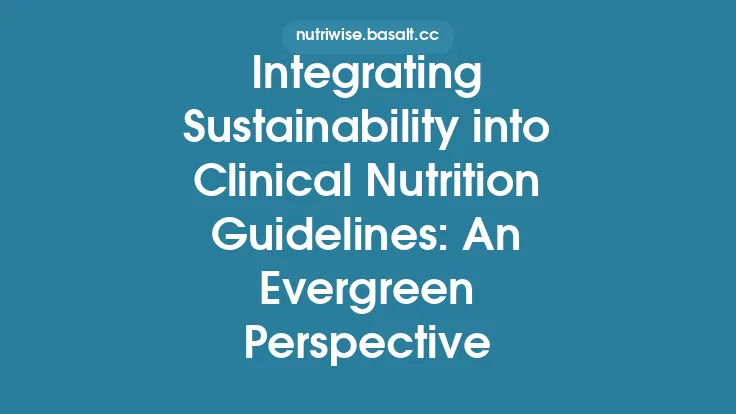The relationship between the way societies produce food and the nutritional health of their populations is a cornerstone of public‑health nutrition research. While agricultural policy has traditionally been driven by goals such as maximizing yield, stabilizing farmer income, and ensuring national food sovereignty, the growing burden of diet‑related chronic diseases has prompted a re‑examination of these priorities. An evergreen perspective on this issue emphasizes principles and mechanisms that remain relevant across political cycles, technological advances, and shifting consumer preferences. Below, we explore the enduring concepts, policy levers, and analytical tools that can help align agricultural systems with nutritional objectives without sacrificing economic viability or environmental stewardship.
Historical Context of Agricultural Policy and Nutrition
Agricultural policy in many countries emerged in the early‑to‑mid‑20th century as a response to food scarcity, price volatility, and the need to support a largely rural workforce. Key instruments—price supports, production quotas, and input subsidies—were designed to stabilize markets and protect farm incomes. Nutrition, at that time, was largely framed in terms of caloric adequacy; the primary public‑health concern was preventing famine and protein‑energy malnutrition.
The post‑World War II era saw the Green Revolution, which dramatically increased the productivity of staple crops such as wheat, rice, and maize through high‑yielding varieties, synthetic fertilizers, and irrigation. While these advances succeeded in reducing under‑nutrition in many low‑ and middle‑income regions, they also entrenched monocultures and narrowed the diversity of foods produced at scale. Consequently, the dietary landscape shifted toward energy‑dense, nutrient‑poor foods, laying the groundwork for the modern epidemic of obesity, type 2 diabetes, and cardiovascular disease.
In the late 20th and early 21st centuries, a growing body of epidemiological evidence highlighted the importance of dietary quality—adequate intake of micronutrients, fiber, and healthy fats—in preventing chronic disease. This evidence spurred a new wave of policy thinking that seeks to integrate nutrition goals into the agricultural agenda, recognizing that the food supply chain is a critical determinant of population health.
Key Policy Instruments Linking Agriculture and Nutrition
1. Crop Diversification Incentives
Governments can encourage the cultivation of nutrient‑rich crops (e.g., legumes, oilseeds, fruits, and vegetables) through targeted subsidies, risk‑management tools, and research funding. By reducing the relative cost of producing these foods, diversification incentives help expand the availability of micronutrient‑dense foods without compromising farm profitability.
2. Nutrient‑Based Standards for Public Procurement
While not directly a school‑meal issue, public procurement for institutions such as hospitals, military bases, and correctional facilities can be structured to prioritize foods that meet specific nutrient criteria. Procurement policies act as a market signal, stimulating demand for healthier agricultural outputs.
3. Integrated Pest Management (IPM) and Soil Health Programs
Sustainable agronomic practices that improve soil organic matter and biodiversity can enhance the micronutrient content of crops. Policies that fund IPM training, cover cropping, and organic amendments indirectly support nutritional outcomes by improving the nutrient density of the food supply.
4. Agricultural Extension and Nutrition Education
Extension services that combine agronomic advice with nutrition education empower farmers to make production decisions that align with health goals. For example, training on biofortified crop varieties (e.g., provitamin A‑rich sweet potatoes) can increase the supply of essential micronutrients.
5. Price Stabilization Mechanisms for Healthy Foods
Traditional price support schemes have focused on staple grains. Extending these mechanisms to include nutrient‑dense crops can reduce price volatility, making healthier foods more affordable for consumers throughout the year.
Nutrient Density and Crop Diversification
Nutrient density—defined as the amount of essential nutrients per unit of energy—varies widely across crop species and varieties. Research consistently shows that legumes, leafy greens, and certain tubers provide higher concentrations of protein, iron, zinc, and vitamins compared to refined cereals. However, the economic returns for farmers often favor high‑yield, low‑input staple crops.
An evergreen strategy to reconcile this tension involves:
- Biofortification: Developing and disseminating crop varieties with enhanced micronutrient profiles (e.g., iron‑enriched beans, zinc‑rich wheat). This approach leverages plant breeding and biotechnology to embed nutrition directly into the agricultural product.
- Mixed‑Cropping Systems: Encouraging intercropping of cereals with legumes or oilseeds can improve soil nitrogen, reduce input costs, and increase overall nutrient output per hectare.
- Seasonal Planning: Aligning planting calendars to ensure a continuous supply of diverse, nutrient‑rich foods throughout the year mitigates seasonal gaps in dietary quality.
Quantitative modeling tools, such as linear programming and nutrient flow analysis, can help policymakers identify optimal crop mixes that meet both economic and nutritional targets under given resource constraints.
Economic Incentives and Market Signals
Market forces ultimately determine what farmers grow and what consumers purchase. Aligning these forces with nutrition goals requires carefully calibrated economic incentives:
- Risk‑Sharing Instruments: Crop insurance schemes that include coverage for nutrient‑dense crops reduce the perceived risk of diversifying away from staples.
- Tax Credits for Sustainable Practices: While not a direct nutrition policy, tax incentives for practices that improve soil health can indirectly raise the nutrient content of harvested produce.
- Value‑Added Processing Support: Grants or low‑interest loans for small‑scale processing (e.g., drying, canning) of fruits and vegetables can expand market access, reduce post‑harvest losses, and increase consumer availability of healthy foods.
Economic analyses should incorporate both producer surplus and consumer welfare to avoid unintended consequences such as price spikes for staple foods.
Trade Policies and Nutritional Implications
International trade shapes domestic food environments by influencing the relative prices and availability of various food groups. An evergreen perspective on trade and nutrition emphasizes:
- Tariff Structures that Favor Nutrient‑Dense Imports: Reducing tariffs on fruits, vegetables, and legumes can lower consumer prices, especially in regions where domestic production is limited.
- Export Restrictions on Essential Nutrients: In times of domestic shortage, temporary export bans on key nutrient‑rich commodities can safeguard national food security without compromising long‑term trade relationships.
- Standards Harmonization: Aligning phytosanitary and quality standards across trading partners facilitates the flow of healthier food products while maintaining safety.
Trade agreements should incorporate health impact assessments to evaluate how changes in market access may affect dietary patterns.
Monitoring and Evaluation Frameworks
Robust, longitudinal data are essential for assessing whether agricultural policies are achieving nutritional objectives. Core components of an evergreen monitoring system include:
- Food Balance Sheets Augmented with Micronutrient Data: Traditional food balance sheets track per‑capita availability of calories; adding micronutrient estimates provides a more complete picture of dietary quality.
- Farm‑Level Production Surveys Linked to Nutrition Indicators: Integrating agronomic data (crop yields, input use) with household nutrition surveys enables causal inference about policy impacts.
- Environmental and Economic Indicators: Tracking soil health, water use, and farm profitability alongside nutrition outcomes ensures that policies remain sustainable across multiple dimensions.
- Policy Dashboards: Interactive platforms that visualize key metrics (e.g., nutrient density of national food supply, price trends for healthy foods) support evidence‑based decision‑making.
Statistical techniques such as difference‑in‑differences, instrumental variable analysis, and structural equation modeling can help isolate the effects of specific policy interventions.
Challenges and Trade‑offs
Balancing agricultural productivity with nutritional quality is not without difficulty. Common challenges include:
- Market Inertia: Established supply chains for staple grains can resist rapid shifts toward diversified production.
- Resource Constraints: Smallholder farmers may lack the capital, knowledge, or infrastructure needed to adopt new crops or practices.
- Policy Silos: Agricultural, health, and trade ministries often operate independently, leading to fragmented strategies.
- Climate Variability: Changing weather patterns can affect the feasibility of cultivating certain nutrient‑dense crops in traditional regions.
Addressing these challenges requires cross‑sectoral coordination, capacity‑building initiatives, and adaptive policy design that can respond to emerging evidence and environmental conditions.
Future Directions and Recommendations
- Integrate Nutrition Metrics into Agricultural Planning
National agricultural strategies should embed nutrient‑density targets alongside yield and income goals. This integration can be operationalized through multi‑criteria decision analysis tools.
- Scale Up Biofortification and Agro‑Ecological Research
Investment in breeding programs and agro‑ecological studies that prioritize both yield stability and nutrient content will generate a pipeline of climate‑resilient, health‑promoting crop varieties.
- Develop Incentive Structures that Reward Nutrient Outcomes
Payment‑for‑ecosystem‑services schemes can be expanded to include “payment for nutrition services,” where farmers receive compensation proportional to the nutritional value of their produce.
- Strengthen Inter‑Agency Governance
Establish permanent inter‑ministerial committees with clear mandates to align agricultural, health, and trade policies, supported by shared data platforms.
- Promote Consumer Awareness of Nutrient Content
While not a front‑of‑package labeling initiative per se, public education campaigns that explain the health benefits of diverse crops can stimulate demand, reinforcing producer incentives.
- Leverage Digital Agriculture for Nutrition‑Sensitive Decision‑Making
Precision farming tools, satellite monitoring, and mobile advisory services can provide real‑time guidance on optimal crop mixes that meet both market and nutrition criteria.
- Implement Pilot Programs with Built‑In Evaluation
Small‑scale, regionally tailored pilots that test novel policy bundles (e.g., combined crop insurance and nutrition education) should be accompanied by rigorous impact assessments to inform scaling.
By embedding these principles into the fabric of agricultural policy, societies can create food systems that are productive, resilient, and conducive to long‑term public‑health nutrition. The evergreen nature of these strategies lies in their adaptability: as scientific knowledge evolves, climate conditions shift, and consumer preferences change, the core idea of aligning what we grow with what our bodies need remains a timeless guide for policymakers.





